Friendly Leeboards
 Leeboards can be
friends. Besides helping you sail to windward - and keeping open the middle of your small craft - what else will help move
your boat caught by marsh grass? Or, hold you there at your pleasure as wind blows and tide floods or ebbs? What else can
help you heave - to by angling forward two lateral planes?
Leeboards can be
friends. Besides helping you sail to windward - and keeping open the middle of your small craft - what else will help move
your boat caught by marsh grass? Or, hold you there at your pleasure as wind blows and tide floods or ebbs? What else can
help you heave - to by angling forward two lateral planes?
Wikipedia says leeboards were in China from at least the eighth century, coming to Europe in 1570. Art from the Anglo-Dutch wars shows Dutch leeboards invading England into the Medway estuary, and leaving much of the British fleet burning. Leeboards have paid their way on British and Dutch shallow water cargo vessels, and U.S. gundalows. The advantages for them are the same as for 10 foot 4 inch Clam Girl - shallow draft and an unobstructed interior.
In the 1903 book Riddle of the Sands, Clara Dollman's dinghy's "tiny leeboards," as shown in the 1979 movie, share the same attachment scheme with massive Dutch vessels.
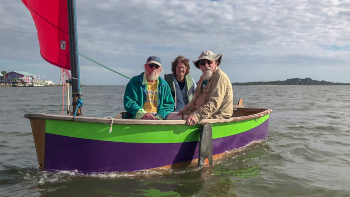 Ted Brewer and LF
Herreshoff's yacht's leeboards followed the Dutch. Ron Johnson, for the Sea Pearl 21, followed them.
Ted Brewer and LF
Herreshoff's yacht's leeboards followed the Dutch. Ron Johnson, for the Sea Pearl 21, followed them.
Gravity, in the Dutch style, brings the boards down and water pressure holds them against the hull's leeward side. After tacking, the new windward board can swivel away from the hull. Sea Pearl sailor Michael Scheibeck emailed, "I always hoisted Magic's weather board about the last thing as she settled on the new tack. Who wants it throwing spray on you?" However, Brewer's "husky coastal cruiser," the capable 34 foot Centennial, had, "A stainless steel bar fitted over her leeboards at the waterline, so that both boards could be left down."
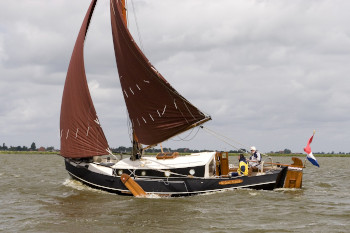 Dutchman Koos Winnips, 47, has sailed an eleven ton
sailing barge for 25 years. The Zeeschouw steel yacht-cruiser, Ouwe Tukker, draws 30 inches; over 8 feet with boards
down. Koos races the Zeeschouw against other traditional boats, and he's a Moth and sailing canoe competitor.
Dutchman Koos Winnips, 47, has sailed an eleven ton
sailing barge for 25 years. The Zeeschouw steel yacht-cruiser, Ouwe Tukker, draws 30 inches; over 8 feet with boards
down. Koos races the Zeeschouw against other traditional boats, and he's a Moth and sailing canoe competitor.
He noted, with a wink, "We get lots of people being scared of those wood things when (rafted up) in crowded harbors... they clamber on the leeboard, then try to grab loose backstays. I say I just painted our decks."
 To "find wilderness" in the densely populated
Netherlands, he and his partner sail across the Waddenzee to the Frisian barrier Islands. Ouwe Tukker dries out on the
enormous, vast sands, much as Clam Girl can rest undisturbed on dry bars in the Cedar Keys. Neither of us will ever
need to prepare for a daggerboard or centerboard jammed in its trunk.
To "find wilderness" in the densely populated
Netherlands, he and his partner sail across the Waddenzee to the Frisian barrier Islands. Ouwe Tukker dries out on the
enormous, vast sands, much as Clam Girl can rest undisturbed on dry bars in the Cedar Keys. Neither of us will ever
need to prepare for a daggerboard or centerboard jammed in its trunk.
British sailing canoeist Baden-Powell said in his 1871 book, Canoe Traveling, "there are two distinct pleasures: one, the healthful enjoyment in fine weather enjoying scenery: and the other, the more sensational, 'cracking on.'"
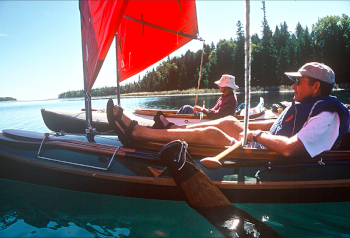 "For ordinary
pleasure (sailing)," he wrote, "The trouble of using a leeboard is hardly repaid by the very small amount of 'weather gauge'
gained on short tacks." But, he wanted, "the help of a wellproportioned and fitted leeboard... for long voyages." His boards'
details I don't know, but, by 1917 sophisticated canoe leeboards used friction, not gravity.
"For ordinary
pleasure (sailing)," he wrote, "The trouble of using a leeboard is hardly repaid by the very small amount of 'weather gauge'
gained on short tacks." But, he wanted, "the help of a wellproportioned and fitted leeboard... for long voyages." His boards'
details I don't know, but, by 1917 sophisticated canoe leeboards used friction, not gravity.
Now in 2020, kayaks and canoes still use friction to position their single boards, as does Clam Girl for both of hers. The problems are the same for Dutch or canoe styles - how to control the boards to stay up or down, and how to make them and their attachment rugged enough for rigorous sailing and rough groundings?
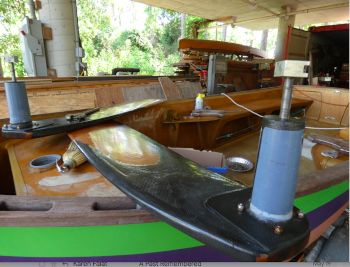 In 2003, Jan Gougeon attached an axle perpendicular to Spirit's leeboard, the axle
turning in a horizontal tube 90 degrees to the centerline of his Serendipity sister. Friction came from squeezing the slotted
tube with a hose clamp. Rather than a cylindrical axle, his proposed evolution has a tapered axle in a cone - a cone clutch.
Clam Girl and later Bufflehead sailing canoes have cones. Friction is easily adjustable.
In 2003, Jan Gougeon attached an axle perpendicular to Spirit's leeboard, the axle
turning in a horizontal tube 90 degrees to the centerline of his Serendipity sister. Friction came from squeezing the slotted
tube with a hose clamp. Rather than a cylindrical axle, his proposed evolution has a tapered axle in a cone - a cone clutch.
Clam Girl and later Bufflehead sailing canoes have cones. Friction is easily adjustable.
On the shortest daysails, leeboards on Clam Girl help Karen and me mingle placid scenery observation with vigorous "cracking on," including abuse of the leeboards in five inch deep water flowing across oyster bars.
And, twice in the autumn of 2020, Clam Girl has "walked" from the salt marsh's grip. The water had been too deep and mucky to pole by shoving a stand up paddle. Kedging was impossible with the five pound Danforth style. Hopping out was no good - I'd sink and get stuck. But, by jamming her boards down, first tugging on one board's handle then the other, I levered her out backwards.
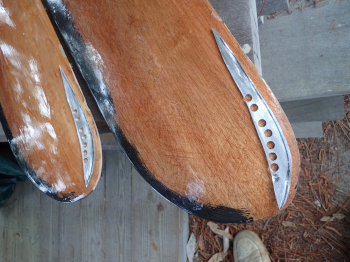 In December's dark days of denials and Covid-19, along with Clam Girl's frothy or
softly sizzling wake, we've smiled with the pinging clank of her rudder blade, and the scraping crunch of wafers of eighth
inch aluminum embedded in the toes of her leeboards.
In December's dark days of denials and Covid-19, along with Clam Girl's frothy or
softly sizzling wake, we've smiled with the pinging clank of her rudder blade, and the scraping crunch of wafers of eighth
inch aluminum embedded in the toes of her leeboards.
~HH
Some photos on this page are from Koos Winnips. Check out his YouTube channel!